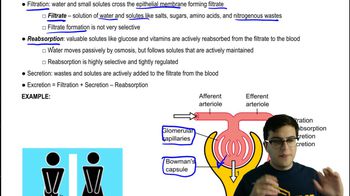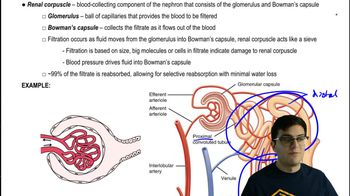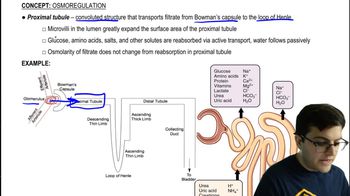Table of contents
- 1. Introduction to Biology2h 40m
- 2. Chemistry3h 40m
- 3. Water1h 26m
- 4. Biomolecules2h 23m
- 5. Cell Components2h 26m
- 6. The Membrane2h 31m
- 7. Energy and Metabolism2h 0m
- 8. Respiration2h 40m
- 9. Photosynthesis2h 49m
- 10. Cell Signaling59m
- 11. Cell Division2h 47m
- 12. Meiosis2h 0m
- 13. Mendelian Genetics4h 41m
- Introduction to Mendel's Experiments7m
- Genotype vs. Phenotype17m
- Punnett Squares13m
- Mendel's Experiments26m
- Mendel's Laws18m
- Monohybrid Crosses16m
- Test Crosses14m
- Dihybrid Crosses20m
- Punnett Square Probability26m
- Incomplete Dominance vs. Codominance20m
- Epistasis7m
- Non-Mendelian Genetics12m
- Pedigrees6m
- Autosomal Inheritance21m
- Sex-Linked Inheritance43m
- X-Inactivation9m
- 14. DNA Synthesis2h 27m
- 15. Gene Expression3h 20m
- 16. Regulation of Expression3h 31m
- Introduction to Regulation of Gene Expression13m
- Prokaryotic Gene Regulation via Operons27m
- The Lac Operon21m
- Glucose's Impact on Lac Operon25m
- The Trp Operon20m
- Review of the Lac Operon & Trp Operon11m
- Introduction to Eukaryotic Gene Regulation9m
- Eukaryotic Chromatin Modifications16m
- Eukaryotic Transcriptional Control22m
- Eukaryotic Post-Transcriptional Regulation28m
- Eukaryotic Post-Translational Regulation13m
- 17. Viruses37m
- 18. Biotechnology2h 58m
- 19. Genomics17m
- 20. Development1h 5m
- 21. Evolution3h 1m
- 22. Evolution of Populations3h 52m
- 23. Speciation1h 37m
- 24. History of Life on Earth2h 6m
- 25. Phylogeny2h 31m
- 26. Prokaryotes4h 59m
- 27. Protists1h 12m
- 28. Plants1h 22m
- 29. Fungi36m
- 30. Overview of Animals34m
- 31. Invertebrates1h 2m
- 32. Vertebrates50m
- 33. Plant Anatomy1h 3m
- 34. Vascular Plant Transport2m
- 35. Soil37m
- 36. Plant Reproduction47m
- 37. Plant Sensation and Response1h 9m
- 38. Animal Form and Function1h 19m
- 39. Digestive System10m
- 40. Circulatory System1h 57m
- 41. Immune System1h 12m
- 42. Osmoregulation and Excretion50m
- 43. Endocrine System4m
- 44. Animal Reproduction2m
- 45. Nervous System55m
- 46. Sensory Systems46m
- 47. Muscle Systems23m
- 48. Ecology3h 11m
- Introduction to Ecology20m
- Biogeography14m
- Earth's Climate Patterns50m
- Introduction to Terrestrial Biomes10m
- Terrestrial Biomes: Near Equator13m
- Terrestrial Biomes: Temperate Regions10m
- Terrestrial Biomes: Northern Regions15m
- Introduction to Aquatic Biomes27m
- Freshwater Aquatic Biomes14m
- Marine Aquatic Biomes13m
- 49. Animal Behavior28m
- 50. Population Ecology3h 41m
- Introduction to Population Ecology28m
- Population Sampling Methods23m
- Life History12m
- Population Demography17m
- Factors Limiting Population Growth14m
- Introduction to Population Growth Models22m
- Linear Population Growth6m
- Exponential Population Growth29m
- Logistic Population Growth32m
- r/K Selection10m
- The Human Population22m
- 51. Community Ecology2h 46m
- Introduction to Community Ecology2m
- Introduction to Community Interactions9m
- Community Interactions: Competition (-/-)38m
- Community Interactions: Exploitation (+/-)23m
- Community Interactions: Mutualism (+/+) & Commensalism (+/0)9m
- Community Structure35m
- Community Dynamics26m
- Geographic Impact on Communities21m
- 52. Ecosystems2h 36m
- 53. Conservation Biology24m
42. Osmoregulation and Excretion
Osmoregulation and Excretion
Problem 6c
Textbook Question
Textbook QuestionThe chloride cells of fish gills have a high density of mitochondria. How does this characteristic relate to the functional role of chloride cells? Would you expect other epithelial cells involved in ion transport to contain large numbers of mitochondria? Explain.
 Verified step by step guidance
Verified step by step guidance1
Step 1: Understand the role of mitochondria. Mitochondria are the powerhouses of the cell, responsible for producing ATP, the cell's main energy currency. This process is known as cellular respiration, where glucose and oxygen are used to produce ATP, carbon dioxide, and water.
Step 2: Understand the role of chloride cells. Chloride cells, also known as ionocytes, are specialized cells in the gills of fish that are involved in ion transport. They help in maintaining the balance of ions (like sodium, chloride, and potassium) in the body of the fish, a process known as osmoregulation.
Step 3: Connect the role of mitochondria to the function of chloride cells. The process of ion transport requires energy, which is provided by ATP. Since mitochondria are responsible for ATP production, the high density of mitochondria in chloride cells indicates that these cells require a lot of energy to perform their function of ion transport.
Step 4: Apply this understanding to other epithelial cells involved in ion transport. Other epithelial cells involved in ion transport would also require energy to perform their function. Therefore, it would be reasonable to expect these cells to contain large numbers of mitochondria as well.
Step 5: Summarize the explanation. The high density of mitochondria in chloride cells and other epithelial cells involved in ion transport is related to the energy requirements of these cells. The process of ion transport requires ATP, which is produced by mitochondria. Therefore, cells involved in ion transport would need a high number of mitochondria to meet their energy needs.
Recommended similar problem, with video answer:
 Verified Solution
Verified SolutionThis video solution was recommended by our tutors as helpful for the problem above
Video duration:
1mPlay a video:
Was this helpful?
Key Concepts
Here are the essential concepts you must grasp in order to answer the question correctly.
Chloride Cells
Chloride cells are specialized epithelial cells found in the gills of fish that play a crucial role in osmoregulation, which is the process of maintaining the balance of salts and water in the body. These cells actively transport chloride ions out of the fish's body, helping to regulate ion concentrations in freshwater or saltwater environments. Their function is vital for the fish's survival in varying salinity conditions.
Recommended video:
Guided course

Cell Junctions
Mitochondria and Energy Production
Mitochondria are known as the powerhouses of the cell, responsible for producing adenosine triphosphate (ATP) through cellular respiration. In chloride cells, the high density of mitochondria indicates a high demand for energy, as active transport of ions requires significant ATP. This energy is essential for the functioning of ion pumps and channels that maintain ionic balance in the fish's body.
Recommended video:
Guided course

Mitochondria
Ion Transport in Epithelial Cells
Epithelial cells involved in ion transport, such as those in the kidneys or intestines, often contain numerous mitochondria to support their energy-intensive functions. These cells utilize active transport mechanisms to move ions against their concentration gradients, which is a process that also requires substantial ATP. Therefore, it is reasonable to expect that other epithelial cells engaged in similar ion transport activities would also exhibit a high mitochondrial density.
Recommended video:
Guided course

Secondary Active Transport

 7:16m
7:16mWatch next
Master Osmoregulation and Nitrogenous Waste with a bite sized video explanation from Jason Amores Sumpter
Start learningRelated Videos
Related Practice



































































